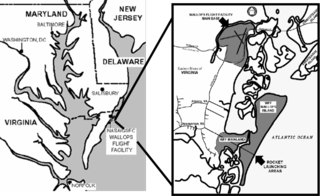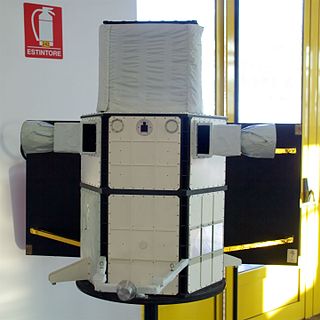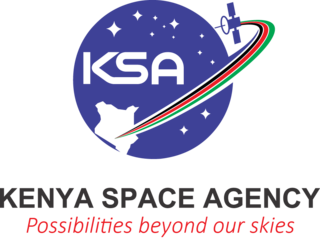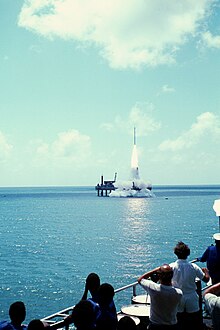
Vega is an expendable launch system in use by Arianespace jointly developed by the Italian Space Agency (ASI) and the European Space Agency (ESA). Development began in 1998 and the first launch took place from the Guiana Space Centre on 13 February 2012.

The Italian Space Agency is a government agency established in 1988 to fund, regulate and coordinate space exploration activities in Italy. The agency cooperates with numerous national and international entities who are active in aerospace research and technology.

Wallops Flight Facility (WFF) is a rocket launch site on Wallops Island on the Eastern Shore of Virginia, United States, just east of the Delmarva Peninsula and approximately 100 miles (160 km) north-northeast of Norfolk. The facility is operated by the Goddard Space Flight Center in Greenbelt, Maryland, and primarily serves to support science and exploration missions for NASA and other Federal agencies. WFF includes an extensively instrumented range to support launches of more than a dozen types of sounding rockets; small expendable suborbital and orbital rockets; high-altitude balloon flights carrying scientific instruments for atmospheric and astronomical research; and, using its Research Airport, flight tests of aeronautical research aircraft, including unmanned aerial vehicles.

The Scout family of rockets were American launch vehicles designed to place small satellites into orbit around the Earth. The Scout multistage rocket was the first orbital launch vehicle to be entirely composed of solid fuel stages. It was also the only vehicle of that type until the successful launch of the Japanese Lambda 4S in 1970.

Salto di Quirra is a restricted weapons testing range and rocket launch site near Perdasdefogu on the island of Sardinia. It is the largest military range in Italy, composed of 12,000 hectares of land owned by the Italian Ministry of Defence and one of the largest in operation within the European Union. Birth defects and cancer in the area have been blamed on weaponry used at the site.

Gaetano Arturo Crocco was an Italian scientist and aeronautics pioneer, the founder of the Italian Rocket Society, and went on to become Italy's leading space scientist. He was born in Naples.

AGILE was an X-ray and gamma ray astronomical satellite of the Italian Space Agency (ASI). Launched in 2007, it de-orbited in February 2024.
Ariel was a British satellite research programme conducted between the early 1960s and 1980s. Six satellites were launched as part of the programme, starting with the first British satellite, Ariel 1, which was launched on 26 April 1962, and concluding with the launch of Ariel 6 on 2 June 1979. The launch of Ariel 1 made Britain the third country to have a satellite orbiting the Earth. The first four were devoted to studying the ionosphere, the remaining two to X-ray astronomy and cosmic-ray studies.
C-41 was a two-stage Italian-built rocket, 75 kg (165 lb) in weight, part of a program to develop probe carrying rockets to study outer atmosphere. It was first launched on July 9, 1960, from the Salto di Quirra range. The project was managed by Lt.Col. Metallo and Engineer Angeloni.
To cut costs the C-41 recycled parts of existing weaponry. The first stage was powered by a cluster of four jets featuring interconnected combustion chambers. The payload carrying second stage was powered by a single engine of the same type. On the whole six C-41 were launched successfully.
Successive development of probe carrying rockets was the task of the newly formed Space Research Committee within the CNR. The committee's president was the founder of Italian astronautics, Luigi Broglio.

The San Marco programme was an Italian satellite launch programme conducted between the early 1960s and the late 1980s. The project resulted in the launch of the first Italian-built satellite, San Marco 1, on 15 December 1964. With the programme Italy became the third country in the world to operate a launch with its own crew, after the Soviet Union and the United States, and the fifth to operate its own satellites after also Canada, and the United Kingdom. San Marco was a collaboration between the Italian Space Research Commission (CRS), led by Luigi Broglio and Edoardo Amaldi, and NASA. In total 5 satellites were launched during the programme, all using American Scout rockets. The first flew from Wallops Flight Facility with the rest conducted from the San Marco Equatorial Range. The last satellite, San Marco-D/L, launched on 25 March 1988.

San Marco 1, also known as San Marco A, was the first Italian satellite. Built in-house by the Italian Space Research Commission on behalf of the National Research Council, it was the first of five as part of the Italian-US San Marco programme.

Luigi Broglio, was an Italian aerospace engineer, airforce lieutenant colonel and dean of the school of aeronautical engineering at the University of Rome La Sapienza. Known as "the Italian von Braun", he is best known as the architect of the San Marco programme.
The space programme of Kenya has been largely shaped by Kenya's equatorial latitude, and has basis of existed foreign infrastructure and experience. The development of the programme started in May 2012.
Milo is a frazione of Trapani, located 4 km southeast of Trapani city on the slopes of Monte Erice on the west coast of Sicily in Italy.

ArgoMoon is a CubeSat that was launched into a heliocentric orbit on Artemis 1, the maiden flight of the Space Launch System, on 16 November 2022 at 06:47:44 UTC. The objective of the ArgoMoon spacecraft is to take detailed images of the Interim Cryogenic Propulsion Stage following Orion separation, an operation that will demonstrate the ability of a cubesat to conduct precise proximity maneuvers in deep space. ASI has not confirmed nor denied whether this took place, but several images of the Earth and the Moon were taken.

Imaging X-ray Polarimetry Explorer, commonly known as IXPE or SMEX-14, is a space observatory with three identical telescopes designed to measure the polarization of cosmic X-rays of black holes, neutron stars, and pulsars. The observatory, which was launched on 9 December 2021, is an international collaboration between NASA and the Italian Space Agency (ASI). It is part of NASA's Explorers program, which designs low-cost spacecraft to study heliophysics and astrophysics.
Carlo Buongiorno was an Italian aerospace engineer, first Director of the Italian Space Agency and professor at the Sapienza University, in Rome. He was a pivotal figure in the Italian space program.
The domain of international space politics gained significant traction during the Cold War. This was largely fuelled by the ongoing space race between the USA and the USSR. At this time in history, space exploration was an endeavour largely restricted to the global superpowers and seemed out of reach for many smaller, developing, nations to actively participate in. Subsequently, public concerns for the cost of research and development into novel space technologies did not receive sufficient policy and academic attention in Africa. As the Cold War reached its conclusion, political power began to diffuse across the world, and this led to many smaller nation states developing national and regional space capabilities. In the context of Africa, Nigeria, Algeria, Egypt and South Africa were the front-runners in terms of investments into space-related research and development.

The Kenya Space Agency(KSA) is mandated to promote, coordinate and regulate space related activities in the country. It was established in 2017 as the successor to the National Space Secretariate (NSS).

















